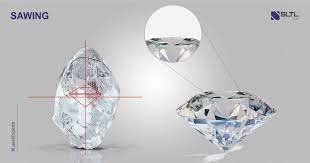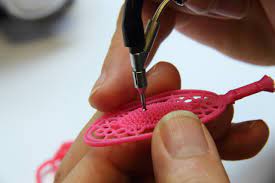Setter
CTOR: INFORMATION TECHNOLOGY- INFORMATION TECHNOLOGY ENABLED
SERVICES (IT-ITES)ces Helpdesk Attendant
SECTOR: GEMS & JEWELLERY
SUB-SECTOR: Handmade Gold and Gems-Set Jewellery
OCCUPATION: Setting
REFERENCE ID: G&J/Q0802
ALIGNED TO: NCO-2004/7313.30
Setter: Also called, ‘Metal Setter’, ‘Setting Goldsmith’, ‘Artisan’ or ‘Benchworker’, the Setter sets gemstones in the collets provided for in the jewellery
frame after it has been finished with all abrasive and chemical polishing
processes.
Brief Job Description: The individual at work in handmade gold jewellery
manufacturing inserts and fixes precious, semi-precious and synthetic
gemstones in the plain gold jewellery frame adorned with gold components.
Personal Attributes: The job requires the individual to have: integrity;
attention to details; good eyesight; steady hands; ability to work in a process
driven team for long hours in sitting position; a lot of patience; and creativity.
The individual must work in small groups in an enclosed area with minimum
hazards when dealing with sharp tools and molten lac.
Set gemstones on jewellery frame
Description This OS unit is about inserting gemstones in the frame and setting it securely
Scope This unit/ task covers the following:
Receive sorted gemstones and jewellery frame from supervisor
understand different shapes, sizes and colour of stones
match stones in the bag with design
understand different jewellery styles
understand different types of stone cut styles such as cabochon (opaque
gemstones usually) and faceted (transparent and diamond usually) in order to
bezel into shallow or pronged groove or with side cuts in bezel
understand different gemstones properties in terms of capacity to withstand
pressure and heat
understand different setting styles such as bezel/ collet setting, channel
setting, prong setting, bead setting, burnish setting and Kundan-jadau setting,
as well as closed and open setting
Set stones
set the polished jewellery frame on lac or wax coated wooden plate
set stones in the collet or channel or ring as per design
boil in hot water to remove lac and achieve clean surface
File excess gold around gemstone setting
understand design requirements such as correct length of prong, bend,
colour, evenness
file or cut sharp edges of prongs
grind for smooth surface
avoid over filing
Detect product defects
inform supervisor if product has arrived with polishing, cleaning, filing or
linking defect from previous processes
understand the type of defect and send to relevant goldsmith
Check quality
check visually in for any defects such as loose stone, tilted setting, marks,
blank spaces
check weight and dimensions of jewellery as per design
understand which alloy allows re-setting of stone and which does not
remove and re-set stone again if returned from QC
Element Performance Criteria
Gemstones setting To be competent, the user/individual on the job must be able to:
PC1. achieve flawless setting as per design requirement
PC2. achieve even colour of stones set, i.e., no discolouration or breakage during
setting
PC3. set stones securely
Controlling gold loss To be competent, the user/individual on the job must be able to:
PC4. maintain loss as per company’s loss margin policy
PC5. document accounts on job sheet as per company policy
Productivity To be competent, the user/individual on the job must be able to:
PC6. deliver in time
PC7. deliver number of frames with gemstones set as per target and of design
quality
Quality of output To be competent, the user/individual on the job must be able to:
PC8. deliver defect free and evenly set
PC9. deliver damage free stones of even colour and well secured
PC10. deliver maximum number of QC-okayed settings
Handling problems To be competent, the user/individual on the job must be able to:
PC11. deliver complete jewellery on time by reporting problems faced or anticipated
well in advance
Knowledge and Understanding (K)
A. Organizational
Context
(Knowledge of the
company /
organization and
its processes)
The individual on the job needs to know and understand:
KA1. company’s policies on: acceptable limits of precious metal loss per product
type, incentives, delivery standards, safety and hazards, security, intellectual
property rights (IPR), and personnel management
KA2. work flow involved in jewellery manufacturing process of the company
KA3. importance of the individual’s role in the workflow
KA4. reporting structure
KA5. typical customer profile and market trends
B. Technical
Knowledge
The individual on the job needs to know and understand:
KB1. handmade jewellery making process
KB2. types of jewellery (product, styles, regional, traditional, making technique)
KB3. uses of different types of tools and techniques for gemstone setting
KB4. basic properties of gemstones and effect of reaction to pressure, heat and
chemicals
KB5. gold alloy properties for securing and rework, i.e., which alloy allows rework
KB6. filing and soldering
The individual on the job needs to know and understand how:
SA1. to read notes and put notes on design
SA2. to use technology such as computer for visual aid or improving efficiency
Measuring and Geometry skills
The individual on the job needs to know and understand how:
SA3. to assess precious metal loss at each step of jewellery making so as to deliver
product of correct weight and size
SA4. to translate design into gems-set jewellery
SA5. to bezel the stone into collet at correct angle for secure and tilt-free placing
Teamwork and multitasking
The individual on the job needs to know and understand how:
SA6. to share work load with other setters as per capability and work load
SA7. to deliver frame to next work process on time
B. Professional Skills Reading design
The individual on the job needs to know and understand how:
SB1. to set stones as per design
SB2. to spot difficulties with respect to practicality of design
Using tools
The individual on the job needs to know and understand how:
SB3. to use the right hand tools for achieving secure setting as per design
SB4. to use tools so that they do not damage jewellery frame or gemstones
SB5. to use tools such as: hammer, tweezers, graver, scoop, wooden plates with lac,
gas torches, table light, needles, burrs, files and soldering system
SB6. to understand safety and hazards involved in using tools
Reducing precious metal loss
The user/individual on the job needs to know and understand:
SB7. prescribed precious metal loss for the entire jewellery piece
SB8. precious-metal loss applicable for setting
SB9. how to reduce precious metal loss below the prescribed standards
SB10. how to follow company’s policies on collecting gold dust and fragments
SB11. how to account in job sheet and return
SB12. how to suggest improvements in order to reduce precious metal loss limits
Reflective thinking
The individual on the job needs to know and understand how:
SB13. to improve work processes
SB14. to work with good posture in a sitting position
SB15. maintain clean work environment and organise tools for ease of use
The individual on the job needs to know and understand how:
SB16. to spot process disruptions and delays
Unit Code G&J/N9910
Unit Title
(Task) Respect IPR of company as well as competitors
Description This OS unit is about maintaining company’s IPR and avoiding infringement on
copyright of others
Scope This unit/task covers the following:
Protect company’s Intellectual Property Rights (IPR)
prevent leak of new designs to competitors by reporting on time
be aware of any of company’s product or design patents
report IPR violations observed in the market, to supervisor or company heads
Avoid infringement to copyright of other companies
read copyright clause of the material published on the internet and any other
printed material
consult supervisor or senior management when in doubt about using publicly
available information
report any infringement observed in the company
Performance Criteria(PC) w.r.t. the Scope
Element Performance Criteria
Respecting IPR To be competent, the user/individual on the job must be able to:
PC1. spot plagiarism and report
PC2. understand rationale of patents and IPR
PC3. avoid being involved in IPR violations
Knowledge and Understanding (K)
A. Organizational
Context
The individual on the job needs to know and understand:
KA1. company’s policies on IPR, plagiarism and order leaks
KA2. company’s patented products
KA3. market trends and company’s unique product range
KA4. reporting structure
B. Technical
Knowledge
The individual on the job needs to know and understand:
KB1. basics of patents and IPR laws
KB2. how IPR protection is important for competitiveness of a company
Skills (S) [Optional]
A. Core Skills/
Generic Skills
Communication skills
The user/individual on the job needs to know and understand how:
SA1. to effectively communicate any observed IPR violations or design leaks
B. Professional Skills Decision making
The user/individual on the job needs to know and understand when and how:
SB1. to report sources of IPR violations
The user/individual on the job needs to know and understand how:
SB2. to learn from past mistakes and report IPR violations on time
Critical thinking
The user/individual on the job needs to know and understand how:
SB3. to spot signs of violations and alert authorities in time
Unit Code G&J/N9912
Unit Title
(Task) Coordinate with co-workers
Description This OS unit is about communicating with colleagues and seniors in order to maintain
smooth ad hazards free work flow
Scope This unit/task covers the following:
Interact with supervisor to:
receive work instructions and raw materials from reporting supervisor
communicate to reporting supervisor about process flow improvements, product
defects received from previous process, repairs and maintenance of tools and
machinery as required
communicate any potential hazards or expected process disruptions
handover completed work to supervisor
Interact with colleagues within and outside the department to:
work as a team with colleagues and share work as per their or own work load and
skills
work with colleagues of other departments such as frame making or component
making or polishing or setting or stores
communicate an discuss work flow related difficulties in order to find solutions
with mutual agreement
receive feedback from QC and rework in order to complete work on time
To be competent, the user/individual on the job must be able to:
PC1. understand the work output requirements
PC2. comply with company policy and rule
PC3. deliver quality work on time as required by reporting any anticipated reasons
for delays
Interactions with
colleagues and other
departments
To be competent, the user/individual on the job must be able to:
PC4. put team over individual goals
PC5. resolve conflicts and multi-task
Knowledge and Understanding (K)
A. Organizational
Context
(Knowledge of the
company /
organization and
its processes)
The individual on the job needs to know and understand:
KA1. company’s policies on personnel management
KA2. work flow involved in company’s jewellery manufacturing process
KA3. importance of the individual’s role in the workflow
KA4. reporting structure
The individual on the job needs to know and understand:
KB1. how to communicate effectively
KB2. how to build team coordination
Skills (S) [Optional]
A. Core Skills/
Generic Skills
Teamwork and some multitasking
The individual on the job needs to know and understand how:
SA1. to share work load as required
SA2. to deliver product to next work process on time
B. Professional Skills Decision making
The individual on the job needs to know and understand:
SB1. how to report potential areas of disruptions to work process
SB2. when to report to supervisor and when to deal with a colleague depending
on the type of concern
Reflective thinking
The individual on the job needs to know and understand:
SB3. how to improve work process
Critical thinking
The individual on the job needs to know and understand:
SB4. how to spot process disruptions and delays
Unit Code G&J/N9914
Unit Title
(Task) Work towards having a safe work environment
Description This OS unit is about being aware of and communicating potential hazards and
dangers of accidents on the job
Scope This unit/task covers the following:
Understand potential sources of accidents
to avoid accidents related to use of potentially dangerous chemicals, gas torches,
sharp tools and hazards from machines
Communicate to reporting supervisor about:
process flow improvements to reduce anticipated or repetitive hazards
mishandling of tools, machines or hazardous materials
electrical problems that could result in accident
To be competent, the user/individual on the job must be able to:
PC1. spot and report potential hazards on time
PC2. follow company policy and rules regarding hazardous materials
PC3. deliver quality work on time as required by reporting any anticipated reasons
for delays
Knowledge and Understanding (K)
A. Organizational
Context
(Knowledge of the
company /
organization and
its processes)
The individual on the job needs to know and understand:
KA1. company’s policies on handling: harmful chemicals and sharp tools, safety and
hazards of machines, fire safety and, disposal of harmful chemicals and
materials
KA2. work flow involved in company’s jewellery manufacturing process
KA3. importance of the individual’s role in the workflow
KA4. reporting structure
B. Technical
Knowledge
The individual on the job needs to know and understand:
KB1. how different chemicals react and what could be the danger from them
KB2. how to use machines and tools without causing bodily harm
KB3. fire safety education
KB4. disposal of hazardous chemicals, tools and materials by following prescribed
environmental norms or as per company policy
Skills (S) [Optional]
A. Core Skills/
Generic Skills
Communication skills
The individual on the job needs to know and understand how:
SA1. to effectively communicate the danger
The individual on the job needs to know and understand:
SB1. importance of reporting potential sources of danger
SB2. appropriate actions to be taken in the event of an accident
SB3. process for disposing of hazardous materials, safely and following
environmental guidelines
Reflective thinking
The individual on the job needs to know and understand how:
SB4. to learn from past mistakes regarding use of hazardous machines or
chemicals or gas torches
Critical thinking
The individual on the job needs to know and understand:
SB5. how to spot danger
SB6. procedures to follow in the event of a fire or other hazard
Keywords /Terms Description
Sector Sector is a conglomeration of different business operations having similar
business and interests. It may also be defined as a distinct subset of the
economy whose components share similar characteristics and interests.
Sub-sector Sub-sector is derived from a further breakdown based on the
characteristics and interests of its components.
Occupation Occupation is a set of job roles, which perform similar/ related set of
functions in an industry.
Function Function is an activity necessary for achieving the key purpose of the
sector, occupation, or an area of work, which can be carried out by a
person or a group of persons. Functions are identified through functional
analysis and form the basis of OS.
Sub-function Sub-functions are sub-activities essential to fulfil the achieving the
objectives of the function.
Job role Job role defines a unique set of functions that together form a unique
employment opportunity in an organisation.
Occupational Standards
(OS)
OS specify the standards of performance an individual must achieve
when carrying out a function in the workplace, together with the
knowledge and understanding they need to meet that standard
consistently. Occupational Standards are applicable both in the Indian
and global contexts.
Performance Criteria Performance criteria are statements that together specify the standard of
performance required when carrying out a task.
National Occupational
Standards (OS)
NOS are occupational standards which apply uniquely in the Indian
context.
Qualifications Pack (QP) QP comprises the set of OS, together with the educational, training and
other criteria required to perform a job role. A QP is assigned a unique
qualifications pack code.
Unit Code Unit code is a unique identifier for an Occupational Standard, which is
denoted by an ‘N’
Unit Title Unit title gives a clear overall statement about what the incumbent
should be able to do.
Description Description gives a short summary of the unit content. This would be
helpful to anyone searching on a database to verify that this is the
appropriate OS they are looking for.
Scope Scope is a set of statements specifying the range of variables that an
individual may have to deal with in carrying out the function which have
a critical impact on quality of performance required.
Knowledge and
Understanding
Knowledge and understanding are statements which together specify the
technical, generic, professional and organisational specific knowledge
that an individual needs in order to perform to the required standard.
Organisational Context Organisational context includes the way the organisation is structured
and how it operates, including the extent of operative knowledge
managers have of their relevant areas of responsibility.
Technical Knowledge Technical knowledge is the specific knowledge needed to accomplish
specific designated responsibilities.
Core Skills/ Generic
Skills
Core skills or generic skills are a group of skills that are the key to learning
and working in today’s world. These skills are typically needed in any
work environment in today’s world. These skills are typically needed in
any work environment. In the context of the OS, these include
communication related skills that are applicable to most job roles.
Keywords /Terms Description
IPR Intellectual Property Rights
NOS National Occupational Standard(s)
NVQF National Vocational Qualifications Framework
NSQF National Qualifications Framework
NVEQF National Vocational Education Qualifications Framework
QP Qualifications Pack
CRITERIA FOR ASSESSMENT OF TRAINEES
Job Role Setter
Qualification Pack G&J/Q0802
Sector Skill Council Gem & Jewellery
Guidelines for Assessment
- Criteria for assessment for each Qualification Pack will be created by the Sector Skill Council. Each
Performance Criteria (PC) will be assigned marks proportional to its importance in NOS. SSC will also lay down
proportion of marks for Theory and Skills Practical for each PC. - The assessment for the theory part will be based on knowledge bank of questions created by the SSC.
- Individual assessment agencies will create theory question papers for candidates at every
examination/training centre. (as per assessment criteria below) - Individual assessment agencies will create practical tests for skill evaluation for candidates at every
examination/training centre. (as per assessment criteria below) - To pass the Qualification Pack, every candidate should score a minimum of 50% in theory and 70% in
practical to successfully clear the assessment. - In case of successfully passing only certain number of NOS’s, the candidate is eligible to take subsequent
assessment on the balance NOS’s to pass the Qualification Pack.








